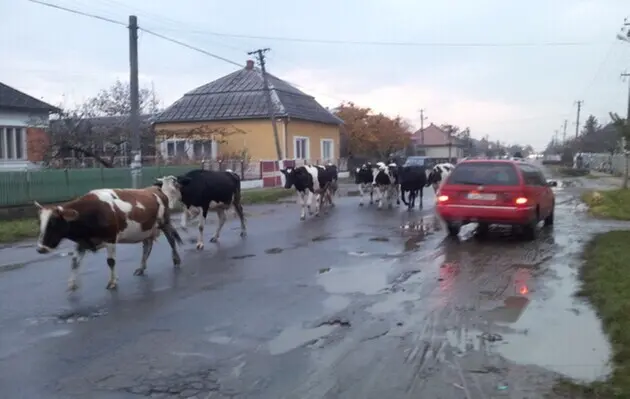VILLAGE AND PEOPLE: WHAT THE STATE SHOULD DO TO SAVE RURAL COMMUNITIES FROM DISAPPEARING
We are traveling to a village we used to visit quite often in the past and still occasionally visit now. A good asphalt road, which didn’t exist before, leads all the way to the village. Even in the village itself, in its central part, about a kilometer of decent asphalt has been laid, symbolizing the amalgamation of communities. But... what immediately catches the eye is the complete absence of people on the streets; at least a third of the houses stand empty. The former bathhouse, which hasn’t been operational since the 1980s, is in ruins, and the old dispensary stands without windows or doors. In the middle of a spacious yard is a large two-story school, clearly having undergone major repairs: new windows, paved paths, and a renovated facade. However, the school does not have a full range of classes — there are too few children. And this is despite the fact that children from several nearby villages are also brought to this school.
Near the store, there are remnants of a monument pedestal, perhaps for Lenin or Marx. The area is littered with trash, broken bushes, and crisscrossed paths, all giving the impression of neglect. Through the overgrown elderberry bushes, you can spot the club where we once watched the film ABBA. I have no idea if anything happens there now. It’s deep autumn, and the road has turned to mud, the black soil slick like engine oil. We barely made it to the club in the darkness and struggled back the same way.
Behind the elderberry-covered ruins of former collective farm buildings, you can see new construction. The locals say a large pig farm is being built here. Overall, the agricultural sector in the village is quite active, though it doesn’t create many jobs. The lost local labor force is now being replaced by workers brought in from other regions of Ukraine, who work on temporary assignments.
Our friends here have a typical rural household for these times. A man and a woman in their 60s. Their daughter and her children live in the city, and their son has been at the front for the past three years. Their village house has been renovated, with gas, central heating, a shower, a bath, and internet. The yard is paved with tiles. There are two cars in the yard: an old “Zhiguli” and a not-so-new “Škoda.” Everything seems fine. But...
There are only a few such households in the village; the majority live in much more modest conditions. The reasons vary, both objective — such as a broken family (the husband drank and died) or poor health — and subjective, likely more psychological. In the village, it’s hard to achieve a decent standard of living through hard work alone; the work is too difficult and unprofitable.
Why were our acquaintances able to manage? After all, they don’t have more land than others — about 0.5 hectares near the house and 1 hectare in the field.
The husband follows the typical work pattern in the family. In the spring, the local agricultural company hires him, and in the fall, they lay him off. During the winter, he registers as unemployed, and in the spring, he returns to work for the same company. The earnings aren’t very high, but cash is as necessary as the pension. However, their main income doesn’t come from wages; it’s from their own household: two cows, two pigs, many chickens, and ducks. All of this requires time and physical effort. Few people can endure such a regime for long. But it’s precisely the milk, cream from the separator, and eggs that provide a stable income since all of it can be sold — sometimes even within the village because many households no longer keep livestock at home — but mostly in the nearby town, where their car comes in handy.
Mrs. Raisa says, “We try, we work like horses, but for whom? Our daughter lives in the city and won’t come back here. Our son won’t stay here either — he needs to get married, but how could he even meet someone here? And when they have children, where will they go to school? The school will definitely close soon; there are already few children, and there will be even fewer. So, I’ll send Vitalik to the city as well. We’ll manage to pull through somehow; it seems like we have more money, but it’s getting harder to earn it every year. Our health isn’t what it used to be. And here, there’s no one to even take your blood pressure — the family doctor is far away and doesn’t visit us, and the ambulance won’t come for high blood pressure either. We have to inject ourselves and even help our neighbors.
Keeping a cow is difficult; there’s nowhere to graze them, as the meadows have been plowed over. I tie it up wherever I can and feed it from the garden. We have enough land to feed everything, and dyrchyk (the small machinery) helps a lot, but the problem is selling what we grow because few people in the village keep livestock anymore. Even the milk and meat buyers come less frequently because there’s so little livestock left, and it’s impossible to transport a calf or cow somewhere to sell it ourselves. Luckily, we now have a terminal where we can pay for electricity and gas, because we don’t have a post office, the internet is poor, and I still haven’t quite figured out how to pay through it.”
In this remark, the village resident has essentially identified the existing problems of rural life, which can be translated into "governance language" and deserve attention:
- The changing age structure of the population, which inevitably leads to fewer opportunities for children and young people to remain in the village.
- The decreasing number of young people of marriageable age and the lack of places for them to meet pushes those still in the village to move to the city to start families.
- Limited opportunities for stable employment in agricultural production due to its seasonal nature and specialization in grain farming. There are no employment opportunities outside of agriculture.
- The declining ability to raise cattle in individual households due to the lack of grazing areas.
- The decreasing opportunities to sell produce from household farms due to small production volumes, which prevents wholesale distribution.
- Health risks due to the distance from primary medical care.
To this, several other serious issues, which are often overlooked by such family households, should be added:
- Growing disparities in poverty levels between rural and urban residents.
- Increasing asymmetry in the quality of rural and urban education.
- A sharp decline in the number of working-age men due to the war.
- Lack of measures to adapt rural households to climate change.
- Weak engagement of households in the use of digital technologies.
- The threat of households being unable to sell livestock products due to non-compliance with European rules/standards that will be implemented in Ukraine.
In general, this set of problems is typical for the vast majority of rural areas in the country. However, among rural territories, three conditional types can be distinguished: rural areas in adverse conditions (peripheral rural areas with extremely low population density), rural areas (regular rural areas with medium population density, not too far from major markets, cities, and transport routes), and suburban rural areas (the most prosperous villages, located as close as possible to large cities — regional centers and cities with populations over 100,000, where employment for the rural population is less dependent on agriculture).
With this analysis of the situation in rural areas, the state should begin to address the identified problems through a system of planning documents that, on the one hand, align with our needs and legislation, and on the other, take into account our European trajectory, focusing on European approaches and indicators for rural development.
The key here is to move away from the paradigm of prioritizing the interests of export-oriented agriculture and to shift state policy from blanket support for large agricultural producers to supporting rural development, communities, and rural residents. After all, rural areas have always been the donors of urban development, contributing not only to the economy but also to the Armed Forces of Ukraine.
Uncoordinated ministry strategies without development
Regarding the State Strategy for Regional Development until 2027 (SSRD-2027), in its version from August 5, 2020, it contained a detailed list of tasks aimed at developing rural areas, which could have enabled the preparation of a comprehensive national program for rural development to achieve the planned results. Unfortunately, COVID-19, the war, and the liquidation of the Ministry of Regional Development hindered the adoption of such a program. The replacement of the current strategy with its updated version, developed by the Ministry of Infrastructure and adopted in August 2024, significantly diluted the idea of state support for rural development. This is especially regrettable in a time when rural areas are suffering the most from the war, and Ukraine should be taking advantage of new opportunities for European integration to access European resources for rural development.
As for the Strategy for the Development of Agriculture and Rural Areas in Ukraine until 2030, the developer, the Ministry of Agrarian Policy, states that it is necessary for Ukraine to fulfill the requirements for EU accession. While that may be true, what is most important for us is the preservation and development of rural areas, focusing primarily on the people, not just millions of tons of grain.
The attempt to combine two very different directions—agricultural development and rural area development—into one strategic document appears not particularly successful in our case. When we talk about agriculture and rural development, we need to strike a balance: how to achieve high agricultural productivity and efficiency without losing the settlement system, jobs, and without depopulating rural areas. Frankly, this is not an easy task.
European experience shows that rural development in the context of intensified agricultural production includes non-agricultural employment for rural residents and a shift in approaches to supporting different typologies of rural areas, from suburban to mountainous or northern regions. What does the draft strategy offer us?
The strategy outlines as many as seven strategic goals, of which only one (!) seemingly relates to rural areas: "Creating conditions for the development of rural areas."
In the other six strategic goals, there is no mention of the individual — the rural resident, their problems, or the state's readiness to address them. Could all this be revealed in the seventh strategic goal? Unfortunately, no.
The tasks identified to achieve this strategic goal sometimes seem outright strange: "Task 1: Approach to rural development" (Is that even a task?). "Task 2: Promote support for young farmers" (Perhaps it should just say "support" instead of "promote"?). "Task 3: Gender equality." And that’s all!
It is clear that despite the war and the exacerbation of crisis situations in rural areas, there is no real planning for supporting the development of these areas in Ukraine. The updated SSRD-2027 and the draft Strategy for the Development of Agriculture and Rural Areas in Ukraine until 2030 limit the state's influence on rural areas to overly general and far from urgent issues. There’s not even a hint of addressing the problems highlighted by Mrs. Raisa in her remark about the real life in rural areas.
We are witnessing two parallel processes for planning state intervention in the development of rural areas: one led by the Ministry of Agrarian Policy, and the other by the Ministry of Infrastructure. These processes are not well-aligned, and there’s little coordination of policy on rural areas between these ministries.
And now the most important question: What should be done?
Firstly, we need to stop perceiving rural development solely within the paradigm of agriculture focused on large producers and instead focus on the people living in rural areas and preserving settlement systems. If these areas become completely depopulated, they will be lost to Ukraine.
Secondly, it is important to return to previously developed measures that were outlined in the earlier version of the SSRD-2027 but remained unimplemented. We need to analyze why these measures were not executed and what needs to be done to ensure they are carried out.
Thirdly, we should analyze new trends in rural development that have emerged over the past two years of war and try to identify the most viable ones, particularly those related to the resettlement of city dwellers to rural areas and the relocation of production forces to secure and expand them. The arrival of new residents from cities to rural areas provides a chance for these territories to recover.
Fourthly, the total destruction of many urban settlements in eastern Ukraine and the impossibility of rebuilding them in their original locations open up opportunities for the establishment and construction of new European-style urban settlements in rural areas, where there is potential for industrial development based on local raw materials.
Fifthly, in some territorial communities with a significant share of rural populations, innovative experiences in solving pressing issues related to education, housing development, individual employment, and attracting new residents have already accumulated. This experience needs to be summarized and made available for dissemination among other communities, along with support for implementation.
Sixthly, these actions will not be possible unless key central executive bodies coordinate their activities in rural areas and rural development policy is recognized as part of the national regional policy.
Seventhly, the newly established Ministry of Regional Development, together with the Ministry of Agrarian Policy and other central executive bodies, must prepare a national regional development program aimed at developing rural areas. This program should take into account current problems, the real situation, development trends, war-related risks, and resource capabilities. This needs to be done as quickly as possible so that the program can be implemented starting from the second half of 2025, after making the necessary adjustments to the state budget of Ukraine.
Eighthly, the role of territorial communities, particularly local councils, in the development of rural areas must be strengthened. The overall idea of creating territorial communities where a city serves as the community center, along with surrounding rural areas, is fundamentally sound. It offers an opportunity to balance the interests of territorial development with those of large agribusinesses, but it has not worked everywhere. In many cases, agribusinesses have effectively formed their own deputy corps within the local councils of certain territorial communities. Today, resolving this problem is difficult, but it is necessary to analyze the electoral system and prepare for its modernization in the future.
Postscript
When we talk about rural life, Mrs. Raisa becomes quite emotional. "Rural people are of no use to anyone. They only care about the land." Unfortunately, this sentiment is shared by many rural residents. The traditional conservatism of rural dwellers has been reinforced by the state's disengagement from solving problems in the countryside. Polish villages, which 20 years ago were in the same neglected state as Ukrainian ones, now look like little jewels. This is a significant reason why Ukrainian villagers do not trust their government.
During the war, some urban residents traditionally relocated to villages — some temporarily, others permanently. This resettlement could greatly help villages withstand the pressure of their problems. New, active people engaged in rural life, along with small farmers, environmentalists, scientists, permaculture advocates, creative people and cultural experts, can and must ensure that Ukrainian villages not only survive but become places where millions of Ukrainians can live comfortably.
Please select it with the mouse and press Ctrl+Enter or Submit a bug















 Login with Google
Login with Google